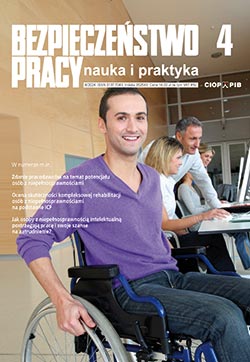The occupational exposure and ventilation of welding workstations
Tomasz Jankowski
Welding is a basic technology for joining metallic materials and plastics. The high occupational exposure of welders results from the presence of various harmful factors that accompany welding processes, including the emission of a mixture of fine particulates (dust) and chemical substances (gases) into the working environment. Mechanical ventilation is the main way to reduce the concentration of air pollutants in the areas where welding works are carried.
The article presents the characteristics of welding fumes, welding process parameters and methods of air distribution with ventilation devices and installations in rooms with welding workstations.
Requirements and test methods for guided type fall arresters including a rigid anchor line
Krzysztof Baszczyński
Guided type fall arresters including a rigid anchor line in the form of rails or wire ropes are elements of personal protective equipment designed to protect against falls from a height intended for worksites where employees have to move in the vertical direction over long distances, e.g., telecommunications towers, wind power plants, transmission towers. This paper presents basic constructions of such devices and the principles of their action. Due to the complex structure of guided type fall arresters and their crucial role in ensuring the users’ safety, they must meet a number of requirements. These requirements and the related test methods are contained both in PN-EN standards and in the Recommendation for Use (RfU) documents prepared by the European Coordination of Notified Bodies Vertical Group 11 – PPE against falls from a height.
To provide the manufacturers and distributors of equipment protecting against falls from a height with a compilation of current requirements and testing methods, this paper presents them divided into groups according to materials and construction, resistance to static loads, and performance and function under dynamic conditions. The importance of tests of the reliability of the function of the devices when climbing or descending with the participation of appropriately selected and trained subjects and tests of the dangerous phenomena that may occur during the fall arrest carried out using anthropomorphic dummies has also been indicated.
Occupational safety and ergonomics in aircraft assembly
Mariusz Dąbrowski
The article presents particular problems of occupational safety and ergonomics in aircraft assembly. Many employees in the aircraft industry in Poland participate in processes of joining materials by riveting, gluing or welding. The article describes typical accidents that may happen during such works and discusses distinctive risks and strenuousness present during application of different technologies of aircraft assembly. The article also provides examples of work equipment and prevention measures for improvement of safety and comfort at work undertaken in the existing legal and technical-organizational conditions.
Needs and expectations of firefighters towards smart protective clothing with the hazards warning system – results of survey research
Anna Dąbrowska, Grażyna Bartkowiak, Tomasz Szmechtyk
Extremely hard environmental conditions during firefighting operations cause that scientific-research works are still performed aimed at development of new kind of smart protective clothing, equipped with systems supporting communication and delivering complex data about firefighters’ health status, as well as about conditions in their surroundings. Those systems can support firefighter’s work and contribute to improvement of his safety during operation. However, it is crucial that they meet firefighters’ expectations and are adjusted to their working conditions. Therefore, this publication presents the results of a survey research carried out among firefighters focused on defining their needs in relation to smart protective clothing with the hazards warning system.




























